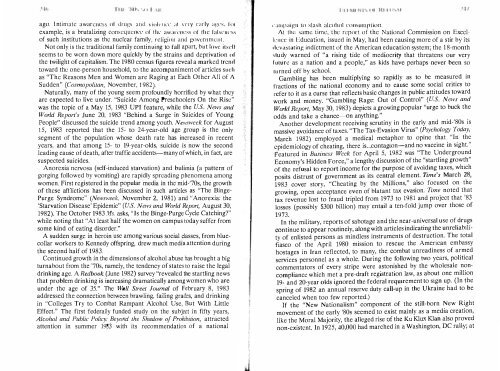CONTENTS - ouroboros ponderosa
CONTENTS - ouroboros ponderosa
CONTENTS - ouroboros ponderosa
Create successful ePaper yourself
Turn your PDF publications into a flip-book with our unique Google optimized e-Paper software.
ago. I ntimate awareness of drugs alld villil'lHT al Vl'ly early ;1'.l'S, rOI<br />
example, is a brutalizing conscqucll('(' or jill' awarCIH:SS of Ihe l'aisl'lIl's.'\<br />
of such institutions as the nuclear family, religioJ} and governmellt.<br />
Not only is thc traditional family continuing to fall apart, but love itself<br />
seems to be worn down more quickly by tbe strains and deprivation of<br />
the twilight of capitalism. The 1980 census figures reveal a marked trend<br />
toward the one-person household, to the accompaniment of articles such<br />
as "The Reasons Men and Women are Raging at Each Othcr All of A<br />
Sudden" (Cosmopolitan, November, 1982).<br />
Naturally, many of the young seem profoundly horrificd by what they<br />
arc cxpected to live under. "Suicide Among Preschoolers On the Rise"<br />
was thc topic of a May 15, 1983 UPI feature, while the US. News and<br />
World Report's June 20, 1983 "Behind a Surge in Suicides of Young<br />
People" discusscd the suicide trend among youth. Newsweek for August<br />
15, 1983 reported that the 15- to 24-year-old age group is the only<br />
segment of thc population whose death rate has increased in recent<br />
ycars, and that among 15- to 19-year-olds, suicide is now the second<br />
leading cause of death, after traffic accidents-many of which, in fact, arc<br />
suspected suicides.<br />
Anorexia nervosa (self-induced starvation) and bulimia (a pattern of<br />
gorging followed by vomiting) are rapidly spreading phenomena among<br />
women. First registered in the popular media in the mid-'70s, the growth<br />
of these aftlictions has been discussed in such articles as "The Binge<br />
Purge Syndrome" (Newsweek, November 2, 1981) and "Anorexia: the<br />
'Starvation Disease' Epidemic" (US. News and World Report, August 30,<br />
1982). The October 1983 Ms. asks, "Is the Binge-Purge Cycle Catching?"<br />
while noting that "At least half the women on campus today suffer from<br />
some kind of eating disorder."<br />
A sudden surge in heroin use among various social ciasses, from blue<br />
collar workers to Kennedy offspring, drew much media attention during<br />
the second half of 1983.<br />
Continued growth in the dimensions of alcohol abuse has brought a big<br />
turnabout from the '70s, namely, the tendency of states to raise the legal<br />
drinking age. A Redbook (June 1982) survey "revealed the startling news<br />
that problem drinking is increasing dramatically among women who are<br />
under the age of 35." The Wa ll Street Journal of February 8, 1983<br />
addressed the connection between brawling, failing grades, and drinking<br />
in "Colleges Try to Combat Rampant Alcohol Use, But With Little<br />
Effec!." The first federally funded study on the subject in fifty years,<br />
Alcohol and Public Policy: Beyond the Shadow of Prohibition, attracted<br />
attention in summer 1983 with its recommendation of a national<br />
';II\lpaign to slash alcohol COllsumption.<br />
At t he: same: time, the re:porl of the National Commission on Excel<br />
h' l I l:e in Education, issued in May, had been causing more of a stir by its<br />
devastating indictment of the American education system; the 18-month<br />
study warned of "a rising tide of mediocrity that threatens our very<br />
future as a nation and a people," as kids have perhaps never been so<br />
turned off by school.<br />
Gambling has been multiplying so rapidly as to be measurd m<br />
fractions of the national economy and to cause some SOCIal cntlcs to<br />
refer to it as a curse that reflects basic changes in public attitudes toward<br />
work and money. "Gambling Rage: Out of Control" (US. News and<br />
World Report, May 30, 1983) depicts a growing popular "urge to buck the<br />
odds and take a chance-on anything."<br />
Another development receiving scrutiny in the early and mid-'80s is<br />
massive avoidance of taxes. "The Tax-Evasion Virus" (Psychology Today,<br />
March 1982) employed a medical metaphor to opine that . "I th<br />
epidemiology of cheating, there is ... contaglon-and no vacc1l1e 111 SIght.<br />
Featured in Business We ek for April 5, 1982 was "The Underground<br />
Economy's Hidden Force," a lengthy discussion of the ' . 'startling growth"<br />
of the refusal to report income for the purpose of aVOldmg taxes, whIch<br />
posits distrust of government as its central element. Time's March 28,<br />
1983 cover story, "Cheating by the Millions," also focused on the<br />
growing, open acceptance even of blatant tax evasion. Tim noted tat<br />
tax revenue lost to fraud tripled from 1973 to 1981 and project that 83<br />
losses (possibly $300 billion) may entail a ten-fold jump over those of<br />
1973.<br />
In the military, reports of sabotage and the near-universal use of drugs<br />
continue to appear routinely, along with articles indicating the unrelIabIlI<br />
ty of enlisted persons as mindless instruments of destruction. The total<br />
fiasco of the April 1980 mission to rescue the Amencan embassy<br />
hostages in Iran reflected, to many, the combat unreadiness of amed<br />
services personnel as a whole. During the fo llowing two years, pohhcal<br />
commentators of every stripe were astonished by the wholesale non<br />
compliance which met a pre-draft registration law, as about one million<br />
19- and 20-year aIds ignored the federal reqUIrement to sIgn up. (In the<br />
spring of 1982 an annual reserve duty call-up in the Ukraine had to be<br />
canceled when too few reported.)<br />
If the "New Nationalism" component of the still-horn New Right<br />
movement of the early '80s seemed to exist mainly as a media creation,<br />
like the Moral Majority, the alleged rise of the Ku Klux Klan also proved<br />
non-existent. In 1925, 40,000 had marched in a Washington, DC rally; at<br />
.






